Scotland's Devolved Employment Services: statistical summary May 2020
This publication presents statistics up to the end of March 2020; covering the first two years of Fair Start Scotland (FSS), which launched in April 2018, and the 21 months of the Health and Work Support pilot which launched in June 2018 and closed in March 2020.
Fair Start Scotland (FSS)
Tables 1 to 5 in the accompanying Excel tables refer to FSS data. Table 5 provides all national totals at Local Authority (LA) level, mapped to FSS Delivery Areas. Caveats that apply to national data also apply to LA data.
How many people have joined FSS?
34,755 people were referred to FSS between its launch in April 2018 and the end of March 2020.
COVID-19 has had an impact on the referral process into FSS with key referring organisations refocusing their work on responding to COVID-19. This will explain some of the drop in referrals in March 2020, illustrated in Figure 1 below. Compared to March 2019, referrals in March 2020 were 31% lower.
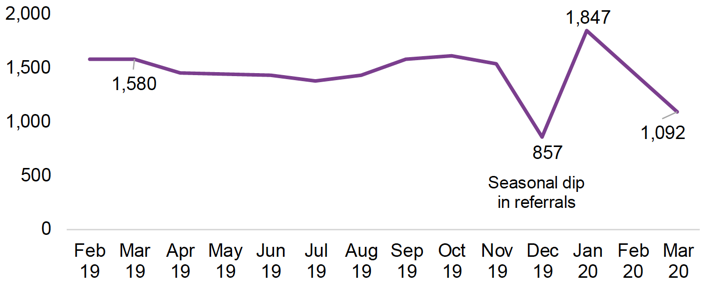
Of those referred since the launch of FSS, 22,138 people went on to receive FSS employability support services. The proportion of referrals starting FSS support has increased over time (see Figure 2). 48% of those referred in quarter one of FSS (April to June 2018) went on to receive support, rising to 69% in October to December 2019. The proportion of starts to referrals has been stable at around 69 to 70% for the last three quarters where start rates are complete, up to December 2019.
The Scottish Government's evaluation of year 1 of FSS[7] found that the most common reason mentioned by participants for engaging with the service was that the support could help them get back to work (45%). A further two-fifths liked the idea of receiving additional help and support (40%)[8].

Note:
1. January to March 2020 start rate is not presented as it is not complete yet.
From the Scottish Government's evaluation of year 1 of FSS[9], we know that compared to the unemployed population of Scotland, there was a higher proportion of men and a lower proportion of women in FSS. There was also a lower proportion of people from a minority ethnic background, a higher proportion of older people, a lower proportion of younger people, and a higher proportion of people with a disability in FSS. Since year 1, there have been changes in the demographic composition of those joining FSS, the latest data (Figure 3) shows that overall:
- 36% of people joining FSS are women and 64% are men. Between year 1 and 2 of FSS there has been a 2 percentage point increase in the proportion of women joining FSS - from 35% to 37%.
- the most common age group for people joining FSS was 35 to 49 years (29% of people), followed by 50 years old and over (27%), 25 to 34 years old (23%), and 16 to 24 years old (18%). Between year 1 and year 2 of FSS the proportion of people joining FSS in the youngest age groups (16 to 34) has increased by 6 percentage points, from 38% to 44%. Conversely, the proportion of people joining FSS in the older age groups (35 and over) has decreased by 9 percentage points, from 60% to 52%
- the majority of people joining FSS are white, with 5% of people joining from minority ethnic backgrounds. A comparison between year 1 and year 2 is not shown here, as the number of participants with missing data is high in year 2[10]. There has been an increase in missing data, with 17% missing in year 1, and 31% in year 2.
- 49% of people joining FSS reported a disability. The proportion reporting a disability decreased by 11 percentage points from 55% in year 1 to 44% in year 2. Conversely, there has been a 10 percentage point increase in the proportion of people joining FSS without a disability
- 65% of people joining FSS reported having a long-term health condition, and 27% reported no long-term health condition, with the rest unknown. Figure 4 shows that the most common health condition reported was mental health (34%). Between year 1 and 2 there was a 5 percentage point increase in people reporting a mental health condition, from 31% to 36%. Physical disabilities were the third most common long-term health condition category reported, and has a 4 percentage point decrease between year 1 and 2 of FSS, from 14% to 11%
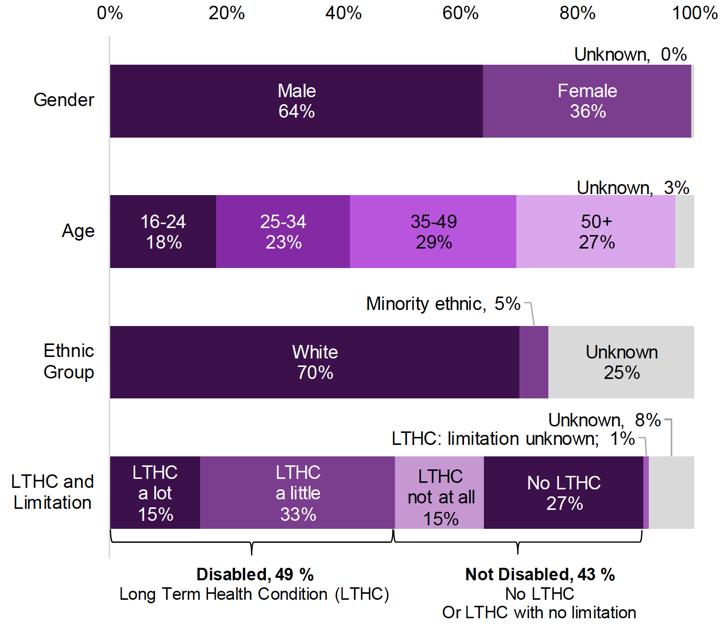
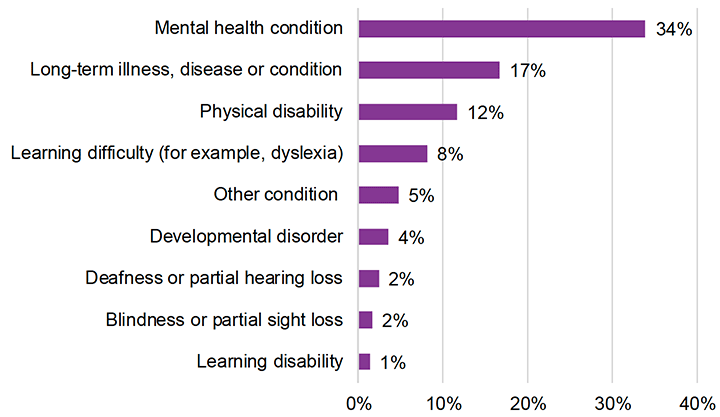
How many have people left FSS early?
An 'early leaver' is defined as someone who leaves FSS before the end of the pre-employment support period and without having sustained employment for at least 3 months. The pre-employment support period usually lasts for up to 1 year. In some cases, it can last up to 18 months, but this has only applied to a small number of people so far.
Overall, 8,118 people have left FSS early. As with job outcomes, this number changes with time - as time goes on we get a more complete picture of numbers staying on FSS or leaving early. Where we have a complete picture[11], 52% of people starting left the service early.
Figure 5 shows that the percentage leaving early is similar for most of the equalities groups. However, the percentage is higher for those reporting a disability, particularly for those who have a long-term health condition that limits daily activities a lot (59% left early). The proportion of people leaving early was lower for those who had a long-term health condition that did not limit daily activities at all (46%).
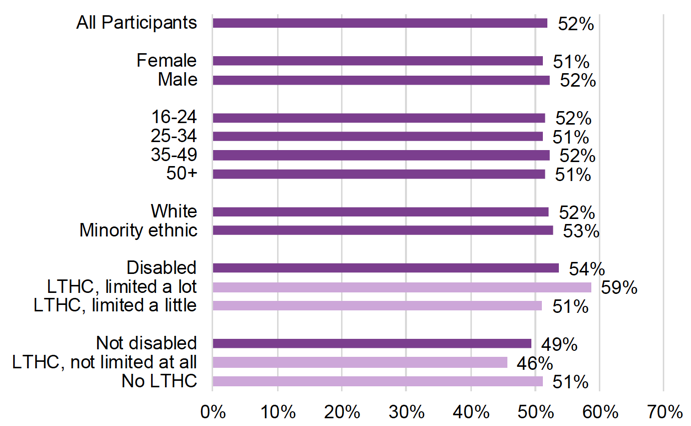
Note:
1. LTHC stands for Long Term Health Condition.
2. The early leaver rate is calculated for people who joined FSS between April 2018 to March 2019 as we have the most complete data . This is 10,063 starts
How many people entered and sustained employment?
A total of 6,166 people joining have started a job - on average taking three months to do so after joining FSS. Job starts were 47% higher in January to March 2020 than in the same period in 2019.
Figure 6 has been included to show any changes in job starts related to the impact COVID-19 has had on the economy. Figure 6 shows that job starts in March 2020 were higher than February 2020 and March 2019, indicating that people were still starting jobs in March. It is too early however to tell if job starts will remain at these levels given the potential impact of COVID-19 on the labour market and the economy.
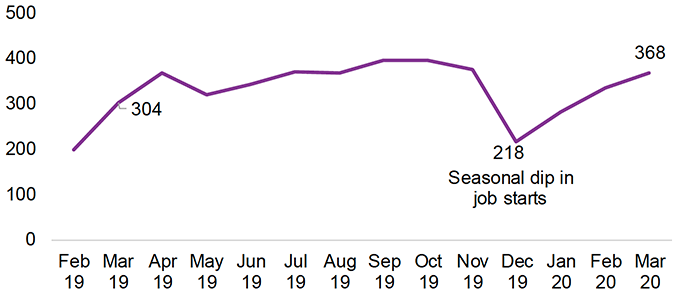
Of the 6,166 people who started work, 3,528 of those had sustained employment for at least 3 months (13 weeks), 2,216 were employed for at least 6 months (26 weeks) and 786 were employed for at least 12 months (52 weeks).
For the majority of people joining FSS, enough time has not lapsed to allow for assessment of sustained employment job outcomes. Whilst we can't report sustained employment outcome rates for all people who started FSS, where we can do so the rates show[12]:
- most people who started FSS did not enter work or go on to sustain employment: 32% started a job, 22% sustained employment for 3 months, and 17% sustained employment for 6 months
- however, most people who started jobs went on to sustain them: 71% of people starting jobs went on to sustain employment for 3 months, and 76% of the people who sustained employment for 3 months went on to reach 6 months
Figures 7, 8 and 9 illustrate the differences in outcome rates that are reported across different equality groups. The largest variation relates to age and long-term health conditions (prevalence of health conditions and age are often related):
- 40% of 16 to 24 year olds started work after joining FSS, whereas a lower proportion (27%) of those aged 50 and above started work – a difference of 13 percentage points. The difference between these two groups narrows when considering 3 month (8 percentage points) and 6 month (3 percentage points) sustained jobs outcomes
- 21% of those with a long-term health condition that limited daily activities a lot went on to start work, whereas a higher proportion (39%) of those with a health condition that did not limit daily activities went on to start work. This is a difference of 18 percentage points. The difference between these two groups narrows when considering 3 month (11 percentage points) and 6 month (8 percentage points) sustained outcomes
It's important to note that whilst this publication reports FSS job starts and sustained outcomes, we cannot report on how FSS is helping people move towards work (progression). Measuring and reporting on progression is particularly important for groups who are furthest away from the labour market as well as in times where there are less labour market opportunities. Please refer to the FSS Year 1 evaluation[13] to understand how FSS helps people move towards work.
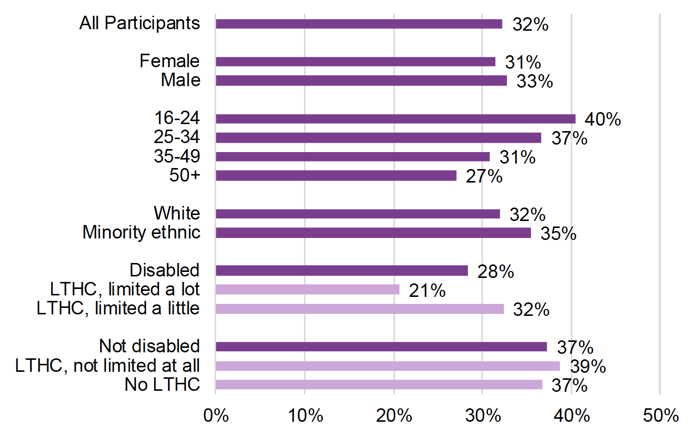
Notes:
1. LTHC stands for Long Term Health Condition.
2. The job start rate is calculated for people who joined FSS between April 2018 to March 2019 as we have the most complete data. This is 10,063 starts.
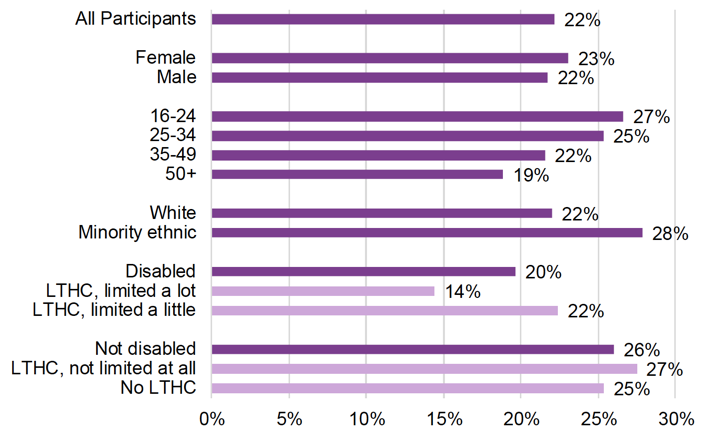
Notes
1. LTHC stands for Long Term Health Condition.
2. The 3 month job outcome rate is calculated for people who joined FSS between April 2018 to December 2018 as we have the most complete data. This is 7,032 starts.
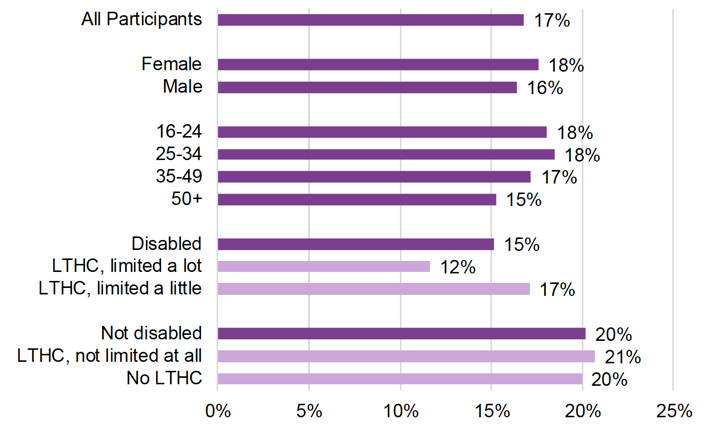
Notes
1. LTHC stands for Long Term Health Condition.
2. The 6 month job outcome rate is calculated for people who joined FSS between April 2018 to September 2018 as we have the most complete data. This is 4,979 starts.
3. Ethnic group is not included here, as the numbers are small.
Contact
Email: employabilitydata@gov.scot
There is a problem
Thanks for your feedback